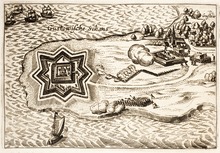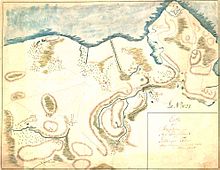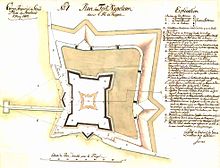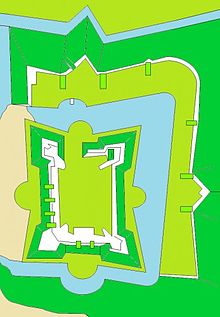Prosnitzer Schanze
Coordinates: 54 ° 16 ′ 16 ″ N , 13 ° 12 ′ 0.4 ″ E The Prosnitzer Schanze (also Neufährschanze , Gustower Schanze , Fort Napoleon ) is a fortification on the southwest coast of Rügen , about 8 km southeast of Stralsund . The location directly on the Strelasund within sight of Stralsund gave it a strategically high value. Especially in the Swedish-Brandenburg War (1674 to 1679) it was fiercely contested and changed hands several times.
Location and construction

The ski jump is located at the narrowest point of the Strelasund. There used to be a ferry service here, which is why the hill was initially called Neufährschanze . From the hill one could monitor the access to the port of Stralsund and also control the traffic between Rügen and the mainland ( Brandshagen ). It was built as a pure earth wall, without masonry. The ski jump consisted of an almost rectangular interior (approx. 80 × 60 m) surrounded by a wall. To the west and south the wall bordered directly on the coast of the Strelasund, on the east and north sides a water-filled ditch was connected, which could be crossed with a bridge on the north side. Outside the trench was the main wall with 2 hornworks , allegedly it was piled up to a height of 10 m.
history
Thirty Years War 1618-1648
During the Thirty Years War , imperial troops were quartered on Rügen , from which the population suffered greatly. Stralsund was well fortified and above all allied with Denmark . Wallenstein tried to get Stralsund to his side, negotiations took a long time, but no agreement was reached. In May 1628 the situation escalated and Stralsund was besieged. To make it more difficult for the Danes to intervene, imperial troops built the first fortifications on Rügen, including the Neufährschanze (Prosnitzer Schanze) as a simple rampart to control the entrance to the port of Stralsund.
Supported by the allied Danes and Swedes , Stralsund was able to withstand the siege by the imperial troops under Wallenstein in 1628. Since Sweden later intervened, Wallenstein was expelled from Stralsund and Rügen in 1630, and Rügen also became Swedish. A small imperial crew remained for a short time on the Altefähr ski jump and the Prosnitzer ski jump, which were also quickly conquered by Sweden. Even after the end of the Thirty Years' War, the ski jumps on Rügen were used, maintained and occupied with troops by Swedes.
Swedish-Brandenburg War 1674 to 1679
In the Swedish-Brandenburg War, Brandenburg-Prussia fought together with the Danes against the Swedes. In September 1677, the Danish King Christian V landed troops on Rügen in order to conquer the Swedish Stralsund from there. The Swedes were defeated and so Rügen was back in the hands of the Danes, only the Neufährschanze remained Swedish. In the next few months, the Neufährschanze served the Swedes as a bridgehead to bring larger troop units to Rügen.
January 1678
At the Battle of Warksow (between Poseritz and Gustow , 4 km north of the Schanze), the Danes, Brandenburgers and Hessians were defeated by Sweden. Rügen was Swedish again. Many Brandenburg prisoners of war were pressed into the Swedish army for service.
September 1678
The island of Rügen was recaptured by Danes and Brandenburgers as early as autumn. On September 16, 1678, Brandenburg troops advanced to the hill. The conquest was very easy for them: the Swedish crew consisted mainly of former Danish and Brandenburg soldiers who mutinied against their Swedish officers and handed the hill over to their former comrades. The Danes also invested in the maintenance of the Neufährschanze and the other fortifications on Rügen and Dänholm .
In the Peace of Saint Germain in 1679 , Denmark and Brandenburg had to give back their former Swedish possessions, the hill was Swedish again.
Great Northern War 1700 to 1721
During the Great Northern War in 1715 the allied Prussians , Saxons, Danes and Hanoverians advanced against the Swedish cities of Wismar and Stralsund. On November 17, 1715, the Neufährschanze was taken, shortly afterwards Stralsund also capitulated. As a result of the Peace of Frederiksborg in 1720, Stralsund and Rügen with all fortifications became Swedish again.
Coalition wars
During the coalition wars, the French began planning a defensive ring around Stralsund consisting of 5 fortresses. It began in 1812 with the Neufährschanze, which was expanded into Fort Napoleon (not to be confused with the much larger Fort Napoleon in Ostend). The wall height was up to 10 meters. As a result of the Congress of Vienna , Rügen and with it the Schanze became Prussian.
German-Danish War
During the German-Danish War of 1864, the Prosnitzer Schanze was equipped with cannons, but it played no special role in the war. The Prosnitzer Schanze kept its function until 1870, after which it was given up and fell into disrepair.
Status
The walls are well preserved. Apart from a few rubble remains, nothing can be found of the buildings that used to stand inside. Overall, the hill is very overgrown and difficult to access. However, their exact geometric shape is still clearly visible in aerial photographs.
Monument protection
The area of the ski jump is a ground monument according to the "Law for the Protection and Maintenance of Monuments in the State of Mecklenburg-Western Pomerania" . Investigations and targeted collection of finds are subject to approval, random finds must be reported to the monument authorities.
Extract from the MV soil monument list for the Prosnitz 15 site:
Sternschanze, 17./19. Century, FlN "Prosnitzer Schanze", "Neufährschanze", "Fort Napoleon"; star-shaped ramparts, in the N, E u. S bounded by moats; in the center of the ski jump - rectangular earthwork with 4 bastions, a round well shaft made of fired bricks.
Report of discovery 2006: Immediately at the Prosnitzer Schanze, a ground conservationist found two leaf tile fragments. The one black glazed piece shows a Renaissance architectural frame, for which there are dated comparisons from the 1st half of the 17th century. The other green glazed fragment comes from a medallion tile. The frame finds comparisons in the middle and the second half of the 16th century.








